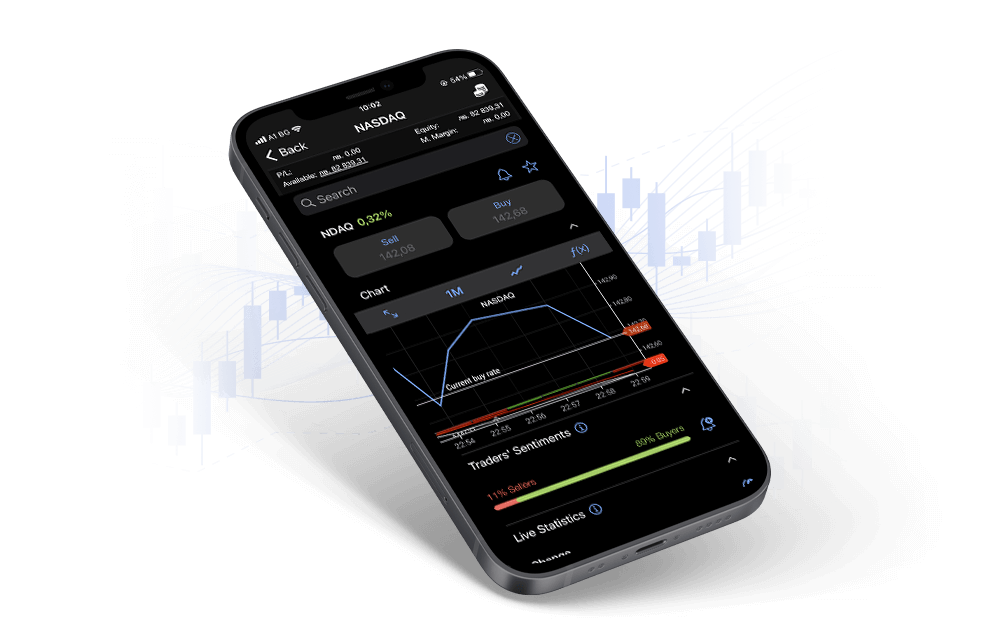What Is the Nasdaq 100 Index?
Date Modified: 27/11/2025
The Nasdaq 100 index is a market-capitalisation-weighted stock market index comprising the 100 largest non-financial companies listed on the Nasdaq Stock Exchange. As a technology-sector-focused benchmark, the Nasdaq 100 price reflects the performance of major tech giants, including Apple, Microsoft, and NVIDIA.
For traders seeking insights into the technology sector and broader market trends, understanding how the Nasdaq 100 price moves is essential. This index serves as a key indicator of innovation-driven companies' performance and offers opportunities through instruments like Nasdaq 100 CFDs.
Here's what you need to know about the Nasdaq 100 index:

TL;DR
- The Nasdaq 100 technology sector index tracks the 100 largest non-financial companies on the Nasdaq Stock Exchange
- Weighted by market capitalisation, with tech giants like Microsoft, Apple, and NVIDIA holding the largest positions
- More concentrated in technology stocks compared to the S&P 500 or Dow Jones Industrial Average
- Trade exposure through Nasdaq 100 futures (NQ ticker), ETFs like QQQ, or CFDs on the Nasdaq 100
- Known for higher volatility than broader indices due to tech sector concentration
- Historical annual returns range from -41.89% (2008) to +101.95% (1999)
What Is the Nasdaq, and When Was the Nasdaq 100 Created?
To understand what the Nasdaq 100 index is, it is important to learn about the Nasdaq Stock Exchange, from which the Nasdaq 100 index emerged.
The Nasdaq Stock Exchange was founded in 1971 by the National Association of Securities Dealers (NASD) and introduced the world’s first computerized trading system that allowed for speedy and transparent trades.
In other words, the Nasdaq allows online trading activity such as the buying and selling of stocks.
The Nasdaq 100 index was created by the NASD in 1985, and you can get a more in-depth overview of the Nasdaq index’s history in our article titled “History of the Nasdaq 100.”
What Does the Nasdaq 100 Index Measure?
The Nasdaq 100 index tracks the share price movements of 100 of the world's largest companies by market capitalisation, excluding financial sector firms. Similar to other major benchmarks, such as the S&P 500 (SPX) and the Dow Jones Industrial Average (USA 30), this index provides a snapshot of market performance.
The Nasdaq 100 is considered a technology sector index due to its heavy weighting towards tech companies. Approximately 50% of the index consists of technology stocks, making it a key barometer for innovation-driven businesses. This concentration provides traders with insight into the collective movements of leading tech firms, which have demonstrated significant growth since the dot-com bubble recovery of the early 2000s.
The index specifically tracks non-financial companies listed on the Nasdaq Stock Exchange according to market capitalisation, offering exposure to sectors including technology, consumer discretionary, healthcare, and telecommunications.
How Is the Nasdaq 100 Index Calculated?
The Nasdaq 100 index employs a modified market capitalisation-weighted methodology. This calculation approach assigns greater influence to companies with larger market capitalisations, meaning movements in shares like Apple or Microsoft have more impact on the overall Nasdaq 100 price than smaller constituents.
The "modified" aspect includes rebalancing rules that prevent any single company from dominating the index. If one company exceeds certain weight thresholds, the index undergoes special rebalancing to maintain diversification. This ensures the Nasdaq 100 share price reflects broader market movements rather than being driven predominantly by one or two mega-cap stocks.
The index value is calculated in real-time during trading hours, with the Nasdaq 100 price updating continuously based on the weighted average of its constituent stocks' price movements.
What Companies Are in the Nasdaq 100?
The Nasdaq100 is made up of some of the world’s largest and most well-known companies.
Here are the Nasdaq 100’s top-listed companies by market capitalization:
Nasdaq 100 Companies* | Market Sector |
Technology | |
Technology | |
Technology | |
Technology | |
Technology | |
Technology | |
Technology | |
TSMC (TSM) | Technology |
Consumer Discretionary | |
Technology |
*Subject to operator availability.
As mentioned above, the Nasdaq is considered tech-heavy as the majority of its constituents are tech stocks.
In total, the index actually consists of 102 symbols, even though there are only 100 companies on the index. This happens when a company has dual listings, such as Google’s parent company, Alphabet.
For example, Alphabet has both ‘Class A’ (GOOGL) and ‘Class C’ (GOOG) listings. These may also be known as ‘Common shares’ and ‘Preferred shares’. The variations offer different benefits to the shareholder, such as voting rights and entitlements to dividend payouts.
Nasdaq 100 Futures: Trading the Index
Nasdaq 100 futures are derivative contracts that enable traders to speculate on the future value of the Nasdaq 100 index. These futures contracts trade under the ticker symbol NQ on the Chicago Mercantile Exchange (CME) and represent one of the most liquid equity index futures markets globally.
Nasdaq 100 futures serve multiple purposes:
- Price Discovery: Futures markets often open before cash markets, providing early indications of market sentiment
- Hedging: Institutional investors use futures to hedge portfolio exposure to technology sector risks
- Speculation: Traders can take leveraged positions on anticipated Nasdaq 100 price movements
- 24-Hour Trading: Unlike the cash index, Nasdaq 100 futures trade around the clock
Each NQ futures contract represents $20 times the Nasdaq 100 index value. For example, if the index trades at 15,000, one contract controls $300,000 of notional value. Micro E-mini Nasdaq 100 futures (MNQ) offer smaller contract sizes at $2 times the index value, making them accessible to retail traders.
For traders seeking exposure without the capital requirements of futures contracts, CFDs on the Nasdaq 100 provide an alternative method to speculate on Nasdaq 100 price movements.
What Sectors Does the Nasdaq 100 Measure?
While the majority of companies on the Nasdaq 100 are from the technology sector, this index also measures the performance of stocks from the following sectors:
- Healthcare
- Consumer Goods & Services
- Industrials
- Financials
- Basic Materials
- Consumer Staples
- Real Estate
- Energy
- Utilities
- Telecommunications
Nasdaq 100 Share Price: Historical Performance and Annual Returns
Nasdaq Price Chart
The Nasdaq 100 price chart demonstrates significant volatility alongside long-term growth, with the technology sector index rising substantially from its 1985 inception through 2024. This trajectory reflects both the sector's innovation-driven expansion and periods of sharp correction during economic downturns.
Notable periods include the dot-com bubble peak in 2000, the 2008 financial crisis decline, and the post-pandemic technology stock surge from 2020 to 2021. Understanding these historical Nasdaq 100 share price movements provides context for current trading conditions and future volatility expectations.

(Source: https://tradethatswing.com/historical-average-returns-for-nasdaq-100-index-qqq/)
Nasdaq Annual Returns
Annual returns are a calculation of the Nasdaq 100’s closing price on the last trading day of the year to the closing price on the last trading day of the following year.
The chart below shows the Nasdaq’s annual returns from 1986 to 2024.
Year | Return |
2024 | 24.88 |
2023 | 53.81 |
2022 | -32.97 |
2021 | 26.63 |
2020 | 47.58 |
2019 | 37.96 |
2018 | -1.04 |
2017 | 31.52 |
2016 | 5.89 |
2015 | 8.43 |
2014 | 17.94 |
2013 | 34.99 |
2012 | 16.82 |
2011 | 2.7 |
2010 | 19.22 |
2009 | 53.54 |
2008 | -41.89 |
2007 | 18.67 |
2006 | 6.79 |
2005 | 1.49 |
2004 | 10.44 |
2003 | 49.12 |
2002 | -37.58 |
2001 | -32.65 |
2000 | -36.84 |
1999 | 101.95 |
1998 | 85.3 |
1997 | 20.63 |
1996 | 42.54 |
1995 | 42.54 |
1994 | 1.5 |
1993 | 10.58 |
1992 | 8.86 |
1991 | 64.99 |
1990 | -10.41 |
1989 | 26.17 |
1988 | 13.54 |
1987 | 10.5 |
1986 | 6.89 |
Nasdaq 100 Index VS. Other Major Indices
The Nasdaq 100 may often be compared to the S&P 500 and the Dow Jones Industrial Average, which are also American stock indices.
Here are the main differences between the three:
Nasdaq 100 VS. the S&P 500
Whereas the Nasdaq 100 is more tech-weighted, and as such, provides a more nuanced overview of the tech market, the S&P 500 is more general as it measures 500 of the leading US companies from various industries.
Nasdaq 100 VS. Dow Jones Industrial Average
The Nasdaq is both a stock market index and an exchange, while the Dow Jones Industrial Average is only an index. Additionally, the Nasdaq only measures Nasdaq-listed stocks, whereas the Dow Jones Industrial Average measures stocks listed on the Nasdaq Exchange and the New York Stock Exchange (NYSE).
How to Trade the Nasdaq 100 Index
Given the Nasdaq 100's importance as a technology sector benchmark and economic indicator, traders have multiple methods to gain exposure to its price movements without directly purchasing all 100 constituent stocks.
Trading Methods:
1. Nasdaq 100 Futures (NQ)
Standard futures contracts on the Chicago Mercantile Exchange offer direct exposure with leverage. Each contract represents $20 times the index value, providing significant market exposure with relatively lower capital requirements than purchasing individual stocks.
2. CFDs on Nasdaq 100
Plus500's Nasdaq 100 CFDs enable traders to speculate on rising and falling Nasdaq 100 share prices without owning the underlying index. CFD features include:
- Ability to trade both long and short positions
- No expiry dates (unlike futures)
- Flexible position sizing (depending on the client's account balance)
- Leveraged trading (trading on margin)
3. ETF CFDs
Traders can also access CFDs on QQQ*, a popular exchange-traded fund that tracks Nasdaq 100 futures performance. This provides an alternative method to gain exposure to the index's price movements.
*Availability subject to operator.
Trading Considerations:
- Market Hours: The cash index trades during U.S. market hours (9:30 AM - 4:00 PM ET), whilst futures trade nearly 24 hours
- Volatility: Technology sector concentration creates higher volatility compared to broader indices
- Earnings Seasons: Quarterly earnings from major constituents like Apple, Microsoft, and NVIDIA can significantly impact the index
- Economic Indicators: Interest rate decisions and inflation data particularly affect technology stocks
Given this index’s importance to the financial markets and the economy, many individuals may be interested in either trading the Nasdaq or investing in the Nasdaq.
*Availability subject to operator.
Nasdaq 100 Volatility & Risks
Beyond the fact that generally speaking, the Nasdaq has yielded multiple returns throughout the years, it is important to note that this index is volatile, and the market can be unpredictable.
Moreover, since this is a tech-heavy index, in times of economic uncertainty and high inflation, it can experience some drops, given the susceptibility of tech stocks to such economic downturns.
Conclusion
The Nasdaq 100 index stands as a vital benchmark for tracking the performance of the world’s leading non-financial companies, with a strong focus on the technology sector. Its market-capitalisation-weighted structure, tech-heavy composition, and historical growth make it a key indicator of innovation and investor sentiment. Whether you're an investor seeking long-term exposure to tech giants or a trader looking to speculate on short-term price movements, understanding the Nasdaq 100’s dynamics, including its volatility, sector composition, and trading instruments, is essential. As global markets evolve, the Nasdaq 100 remains a key indicator for assessing the health and direction of the modern digital economy.
*Past performance does not reflect future results. The above are only projections and should not be taken as investment advice.
FAQs
The Nasdaq 100 is weighted by market capitalization. This means that the Nasdaq’s value is based on the total value of the Nasdaq 100 companies’ shares multiplied by their closing prices.
Some of the 100 companies on the Nasdaq include Amazon, Alphabet, Apple, NVIDIA, Netflix, and more.
Some of the factors that can shift the Nasdaq 100 include market sentiment, companies’ earnings, and political news.
The Nasdaq 100’s sectors are consumer discretionary, basic materials, technology, health care, consumer staples, industrials, telecommunications, and utilities.
Learn More About Nasdaq 100
Related News & Market Insights
Get more from Plus500
Expand your knowledge
Learn insights through informative videos, webinars, articles, and guides with our comprehensive Trading Academy.
Explore our +Insights
Discover what’s trending in and outside of Plus500.
Stay up-to-date
Never miss a beat with the latest News & Markets Insights on major market events.


